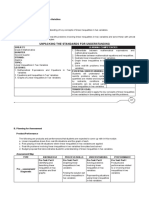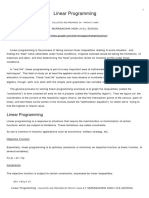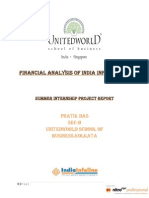Problems in Linear Programming
Uploaded by
BBAM I 2014Problems in Linear Programming
Uploaded by
BBAM I 2014Problems in Linear Programming
Question 1.
A calculator company produces a scientific calculator and a graphing
calculator. Long-term projections indicate an expected demand of at least
100 scientific and 80 graphing calculators each day. Because of limitations
on production capacity, no more than 200 scientific and 170 graphing
calculators can be made daily. To satisfy a shipping contract, a total of at
least 200 calculators much be shipped each day.
If each scientific calculator sold results in a $2 loss, but each graphing
calculator produces a $5 profit, how many of each type should be made
daily to maximize net profits?
Question 2.
Question 3.
You need to buy some filing cabinets. You know that Cabinet X costs $10
per unit, requires six square feet of floor space, and holds eight cubic feet
of files. Cabinet Y costs $20 per unit, requires eight square feet of floor
space, and holds twelve cubic feet of files. You have been given $140 for
this purchase, though you don't have to spend that much. The office has
room for no more than 72 square feet of cabinets. How many of which
model should you buy, in order to maximize storage volume?
Given the following constraints, maximize and minimize the value of
z = 0.4x + 3.2y.
Question 4.
In order to ensure optimal health (and thus accurate test results), a lab
technician needs to feed the rabbits a daily diet containing a minimum of
24 grams (g) of fat, 36 g of carbohydrates, and 4 g of protien. But the
rabbits should be fed no more than five ounces of food a day.
Rather than order rabbit food that is custom-blended, it is cheaper to order
Food X and Food Y, and blend them for an optimal mix. Food X contains 8
g of fat, 12 g of carbohydrates, and 2 g of protein per ounce, and costs
$0.20 per ounce. Food Y contains 12 g of fat, 12 g of carbohydrates, and 1 g
of protein per ounce, at a cost of $0.30 per ounce.
What is the optimal blend?
Question 5.
You have $12,000 to invest, and three different funds from which to
choose. The municipal bond fund has a 7% return, the local bank's CDs
have an 8% return, and the high-risk account has an expected (hoped-for)
12% return. To minimize risk, you decide not to invest any more than
$2,000 in the high-risk account. For tax reasons, you need to invest at least
three times as much in the municipal bonds as in the bank CDs. Assuming
the year-end yields are as expected, what are the optimal investment
amounts?
You might also like
- Solution Manual For Financial Accounting An Introduction To Concepts Methods and Uses 13th Edition by Stickney100% (1)Solution Manual For Financial Accounting An Introduction To Concepts Methods and Uses 13th Edition by Stickney32 pages
- Integral University: Department of Computer ApplicationNo ratings yetIntegral University: Department of Computer Application5 pages
- Linear Programming Exercises: Setup The LP Models For The FollowingNo ratings yetLinear Programming Exercises: Setup The LP Models For The Following3 pages
- Amity Centre For Elearning: Program: Semester-INo ratings yetAmity Centre For Elearning: Program: Semester-I10 pages
- RPA Design & Development: Data ManipulationNo ratings yetRPA Design & Development: Data Manipulation62 pages
- Computational Science and Numerical MethodsNo ratings yetComputational Science and Numerical Methods8 pages
- Chapter 3 - Introduction To Linear Programming ANo ratings yetChapter 3 - Introduction To Linear Programming A37 pages
- t06 Principles of Cost Accounting and Procurement100% (1)t06 Principles of Cost Accounting and Procurement317 pages
- Introduction To MCDM Techniques: AHP As Example: August 2019No ratings yetIntroduction To MCDM Techniques: AHP As Example: August 201942 pages
- Relation Between Linear and Nonlinear Linear Programming ChapterNo ratings yetRelation Between Linear and Nonlinear Linear Programming Chapter8 pages
- Introduction To Differential Calculus PDFNo ratings yetIntroduction To Differential Calculus PDF45 pages
- Preprocessor Directives: Separate Step in The Compilation ProcessNo ratings yetPreprocessor Directives: Separate Step in The Compilation Process40 pages
- Chapter 1 - Basic Concepts of StatisticsNo ratings yetChapter 1 - Basic Concepts of Statistics12 pages
- Discount and Sale Price Lesson 2 of 9: Unit 10100% (1)Discount and Sale Price Lesson 2 of 9: Unit 103 pages
- Lecture 2 - Binary Numbers, Python Basics PDFNo ratings yetLecture 2 - Binary Numbers, Python Basics PDF62 pages
- Sat - 13.Pdf - Child Mortality Prediction Using Machine LearningNo ratings yetSat - 13.Pdf - Child Mortality Prediction Using Machine Learning11 pages
- Linear Programming Problem: Ajay Kumar SinhaNo ratings yetLinear Programming Problem: Ajay Kumar Sinha8 pages
- 10.4 Applications of Numerical Methods Applications of Gaussian Elimination With PivotingNo ratings yet10.4 Applications of Numerical Methods Applications of Gaussian Elimination With Pivoting11 pages
- Performance Evaluation of Machine Learning Algorithms in Post-Operative Life Expectancy in The Lung Cancer PatientsNo ratings yetPerformance Evaluation of Machine Learning Algorithms in Post-Operative Life Expectancy in The Lung Cancer Patients11 pages
- Cse1006 Blockchain-And-cryptocurrency-technologies TH 1.0 0 Blockchain and Cryptocurrency TechnologiesNo ratings yetCse1006 Blockchain-And-cryptocurrency-technologies TH 1.0 0 Blockchain and Cryptocurrency Technologies2 pages
- Data Structures and Algorithms: Asymptotic NotationsNo ratings yetData Structures and Algorithms: Asymptotic Notations28 pages
- LPP INTRODUCTION DEFINITIONAND EXAMPLES OF Linear Programming IntroNo ratings yetLPP INTRODUCTION DEFINITIONAND EXAMPLES OF Linear Programming Intro18 pages
- Digital Image Processing Lecture Notes: M.Sc. Cs - (Iv Sem) (2020-2021)No ratings yetDigital Image Processing Lecture Notes: M.Sc. Cs - (Iv Sem) (2020-2021)28 pages
- Syllabus: Paper - CH 2.1: Semester - II Business StatisticsNo ratings yetSyllabus: Paper - CH 2.1: Semester - II Business Statistics3 pages
- Practical 01 Question For Database ManagementNo ratings yetPractical 01 Question For Database Management1 page
- Group Cohessiveness and Norms - Web Version100% (1)Group Cohessiveness and Norms - Web Version15 pages
- Jesus Heals The Leper: Cathedral Sunday MassesNo ratings yetJesus Heals The Leper: Cathedral Sunday Masses8 pages
- Working With Spreadsheets: Basics: Creating ChartsNo ratings yetWorking With Spreadsheets: Basics: Creating Charts16 pages
- Financial Review: Summary of Financial PerformanceNo ratings yetFinancial Review: Summary of Financial Performance5 pages
- IBF-AFS - Theory & Questions TVM, EOQ & Basic Accounting ConceptsNo ratings yetIBF-AFS - Theory & Questions TVM, EOQ & Basic Accounting Concepts40 pages
- Financial Analysis of India Infoline LTD Final100% (1)Financial Analysis of India Infoline LTD Final51 pages
- J.P. Morgan Saudi Arabia Limited: Board Report 2016No ratings yetJ.P. Morgan Saudi Arabia Limited: Board Report 201632 pages
- CFRAEquityResearch_HoneywellInternationalInc_Dec_14_2024No ratings yetCFRAEquityResearch_HoneywellInternationalInc_Dec_14_20249 pages
- Option Valuation Option Valuation: Fundamentals InvestmentsNo ratings yetOption Valuation Option Valuation: Fundamentals Investments40 pages
- Relevant Costs For Non Routine Decision MakingNo ratings yetRelevant Costs For Non Routine Decision Making46 pages
- ESSEC Brochure - Master - in - Finance PDFNo ratings yetESSEC Brochure - Master - in - Finance PDF20 pages
- Subsidiarys of Citigroup Inc. 2009 Exhibit21-01No ratings yetSubsidiarys of Citigroup Inc. 2009 Exhibit21-015 pages
- Sworn Statement of Assets, Liabilities and Net WorthNo ratings yetSworn Statement of Assets, Liabilities and Net Worth2 pages
- State Controls, Markets and Washington ConsensusNo ratings yetState Controls, Markets and Washington Consensus27 pages
- IFRS 12 - Disclosure of Interests in Other EntitiesNo ratings yetIFRS 12 - Disclosure of Interests in Other Entities19 pages
- PE - Norway Pension Fund - Evaluatin Investments in PE (Ver P. 32)No ratings yetPE - Norway Pension Fund - Evaluatin Investments in PE (Ver P. 32)154 pages
































































































